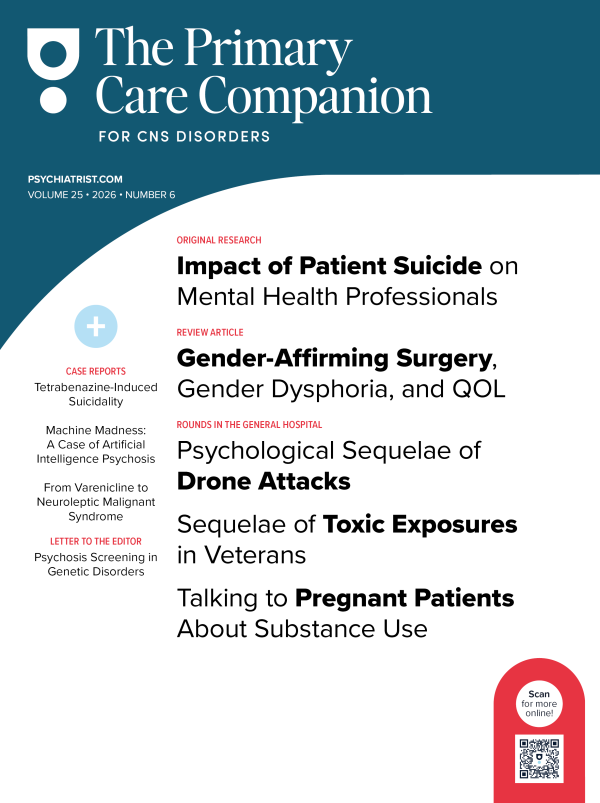Wernicke-Korsakoff syndrome (WKS) is a neuropsychiatric disorder caused by thiamine deficiency.1 Apart from chronic alcoholism, it is also seen in conditions with increased thiamine demand, like gastrointestinal diseases or surgery, dietary insufficiency, vomiting, and immunodeficiency syndromes, as well as in pregnant and lactating women.1–3 Nonalcoholic WKS remains undiagnosed in most cases since it requires a high degree of clinical suspicion. Here, we present a case of WKS with 6 years of visual and auditory perceptual disturbances following a history of hyperemesis gravidarum.
Case Report
A 31-year-old married woman with an obstetric score of para 1, living 1 presented with a history of fluctuating but gradually worsening course of illness characterized by gait instability, nystagmus along with perceptual disturbances, apathy, and deficits in attention and memory for the last 6 years. She reported difficulty managing housework but could manage basic activities such as eating and dressing.
Upon exploration, we found a history of intractable nausea, vomiting, and weight loss of 10 kg (22 lb) between her second and fourth months of pregnancy 6 years ago. During her fifth month of pregnancy, she developed upper limb and head tremors, wide-based gait, and speech difficulties. By the seventh month, she experienced nonpervasive low mood, social withdrawal, immediate and recent memory difficulties, and persecutory and referential ideas, accompanied by visual and auditory hallucinations. At 9 months of gestation, she delivered a healthy baby with no immediate perinatal complications. There was no history of seizures. She was treated in the past with antipsychotics, escitalopram, and memantine without much improvement.
On examination, mild bradykinesia, broad-based gait, postural tremors, postural instability, bilateral nystagmus, ophthalmoplegia, incoordination, dysarthria, and speech impairment were noted. The mental status examination showed apathy, restricted affect, poor eye contact, and uncontrollable crying episodes. She reported visual and auditory hallucinations with persecutory content. Her Hindi Mental Status Examination4 score was 18/30, with assessments limited by apathy and noncooperation. Neuropsychological assessment could not be completed due to noncooperation.
Her blood investigations, including a sexually transmitted diseases panel and electroencephalography, were within normal limits. Brain magnetic resonance imaging (MRI) showed moderate cerebellar atrophy with prominent folia. Autoimmune antibody studies and routine cerebrospinal fluid analysis were negative. Serum paraneoplastic profile revealed 1+ positive titers of antiamphiphysin antibodies, which is not significant unless clinical features correlate. The whole-body emission tomography MRI showed cerebellar atrophy without altered metabolism/ inflammatory processes or any primary neoplasia.
The patient received parenteral thiamine 600 mg/day for 7 days and continued clozapine 100 mg/day and memantine 10 mg/day. The patient stayed in the hospital for a week with symptoms remaining the same. A methylprednisolone trial was advised by the neurology team but could not be given, as the patient chose to be discharged. She was referred to consult locally for further management.
Discussion
Acute WKS, or Wernicke’s encephalopathy, is diagnosed using Caine’s criteria, requiring at least 2 of 4 features: dietary deficiencies, oculomotor abnormalities, cerebellar dysfunction, and altered mental status/ mild memory impairment.3 Chronic WKS, or Korsakoff syndrome, presents with cognitive heterogeneity, wherein impairment extends beyond selective memory deficits to include broader cognitive dysfunction, including executive dysfunction with variable prognosis. Both acute and chronic phases of WKS exhibit heterogeneous clinical presentations with cognitive deficits, and due to its variable course, acute Wernicke’s encephalopathy and chronic Korsakoff syndrome can be described under the broader term WKS.5 Our patient exhibited the above symptoms, consistent with a clinical diagnosis of WKS. A review found nonalcoholic WKS had female predominance, earlier onset (<40 years), short duration between precipitating factor and onset of presentation, and better survival.2 In the context of some supporting clinical features, inconclusive imaging, and low antibody titers, antiamphiphysin encephalitis was considered as a differential rather than a primary diagnosis in this case.6
A high degree of clinical suspicion and prompt diagnosis are crucial for managing nonalcoholic WKS. This case is distinct due to its presentation being missed during pregnancy leading to chronicity, and possibility of a differential diagnosis. All pregnant women with excessive vomiting should receive thiamine supplementation, as it is affordable and readily available and can prevent this debilitating condition.
Article Information
Published Online: July 3, 2025. https://doi.org/10.4088/PCC.25cr03934
© 2025 Physicians Postgraduate Press, Inc.
Prim Care Companion CNS Disord 2025;27(4):25cr03934
Submitted: February 3, 2025; accepted April 10, 2025.
To Cite: Mandal A, Narasimhappa K, Dahale AB. From emesis to amnesia: Wernicke-Korsakoff syndrome due to hyperemesis gravidarum. Prim Care Companion CNS Disord 2025;27(4):25cr03934.
Author Affiliations: Department of Psychiatry, National Institute of Mental Health and Neurosciences, Bengaluru, Karnataka, India (all authors).
Corresponding Author: Karthik Narasimhappa, MD, Department of Psychiatry, National Institute of Mental Health and Neurosciences, Hosur Rd, Bengaluru, Karnataka India ([email protected]).
Relevant Financial Relationships: None.
Funding/Support: None.
Previous Presentation: Poster presented at the 10th World Congress of Women’s Mental Health (IAWMH 2025); March 2025; Bengaluru, India.
Patient Consent: Consent was received from the patient to publish the case report, and information has been de-identified to protect anonymity.
References (6)

- Sechi G, Serra A. Wernicke’s encephalopathy: new clinical settings and recent advances in diagnosis and management. Lancet Neurol. 2007;6(5):442–455. PubMed CrossRef
- Scalzo SJ, Bowden SC, Ambrose ML, et al. Wernicke Korsakoff syndrome not related to alcohol use: a systematic review. J Neurol Neurosurg Psychiatry. 2015;86(12):1362–1368. PubMed CrossRef
- Galvin R, Bråthen G, Ivashynka A, et al. EFNS guidelines for diagnosis, therapy and prevention of Wernicke encephalopathy. Eur J Neurol. 2010;17(12):1408–1418. PubMed CrossRef
- Ganguli M, Ratcliff G, Chandra V, et al. A Hindi version of the MMSE: the development of a cognitive screening instrument for a largely illiterate rural elderly population in India. Int J Geriatr Psychiatry. 1995;10(5):367–377. CrossRef
- Scalzo SJ, Bowden SC. Over a century of study and still misunderstood: recognizing the spectrum of acute and chronic Wernicke–Korsakoff syndrome. J Clin Med. 2023;12(21):6880. PubMed CrossRef
- Sun Y, Qin X, Huang D, et al. Anti-amphiphysin encephalitis: expanding the clinical spectrum. Front Immunol. 2023;14:1084883. PubMed CrossRef
Please sign in or purchase this PDF for $40.





